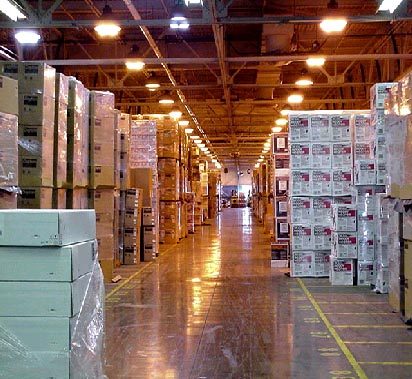The production system developed by Toyota Motor Corporation to provide
best quality, lowest cost, and shortest lead time through the elimination of
waste. TPS is comprised of two pillars, just-in-time and jidoka, and often is
illustrated with the “house” shown at right. TPS is maintained and improved
through iterations of standardized work and kaizen, or the scientific method.
Development of
TPS is credited to Taiichi Ohno, Toyota’s chief of production in the post-WW II
period. Beginning in machining operations and spreading from there, Ohno led
the development of TPS at Toyota throughout the 1950s and 1960s, and the
dissemination to the supply base through the 1960s and 1970s. Outside Japan,
dissemination began in earnest with the creation of the Toyota- General Motors
joint venture in California in 1984.
The concepts of
just-in-time (JIT) and jidoka both have their roots in the prewar period.
Sakichi Toyoda, founder of the Toyota group of companies, invented the concept
of jidoka in the early 20th Century by incorporating a device on his automatic
looms that would stop the loom from operating whenever a thread broke. This
enabled great improvements in quality and freed people to do more valuecreating
work than simply monitoring machines for quality. Eventually, this simple
concept found its way into every machine, every production line, and every
Toyota operation.
Kiichiro
Toyoda, son of Sakichi and founder of the Toyota automobile business, developed
the concept of JIT in the 1930s. He decreed that Toyota operations would
contain no excess inventory and that Toyota would strive to work in partnership
with suppliers to level production. Under Ohno’s leadership, JIT developed into
a unique system of material and information flows to control overproduction.
Widespread
recognition of TPS as the model production system grew rapidly with the
publication in 1990 of The Machine That Changed
the World, the result of five years
of research led by the Massachusetts Institute of Technology. The MIT
researchers found that TPS was so much more effective and efficient than
traditionalmass production that it represented a completely new paradigm and
coined the term lean production to indicate this radically different approach
to production.
Just In Time
It is perhaps
not widely known that the 'just in time' approach to production that has now
gained almost universal acceptance in world manufacturing was actually
pioneered by Toyota. In fact, a Toyota engineer coined the term itself.
This, too, is
a simple but inspired application of common sense.
Essentially,
'just in time' manufacturing consists of allowing the entire production process
to be regulated by the natural laws of supply and demand.
Customer
demand stimulates production of a vehicle. In turn the production of the
vehicle stimulates production and delivery of the necessary parts and so on.
The result is
that the right parts and materials are manufactured and provided in the exact
amount needed - and when and where they are needed.
Under 'just
in time' the ultimate arbiter is always the customer. This is because activity
in the system only occurs in response to customer orders. Production is
'pulled' by the customer rather than being 'pushed' by the needs or
capabilities of the production system itself.
The linkage
between customer demand and production is made by analysing takt time, a device
for measuring the pace of sales in the market in relation to the capacity of a
manufacturing plant. For example, if a plant operates for 920 minutes per day
and daily demand is for 400 vehicles, then takt time will be 2.3 minutes.
If takt times
are reduced more resources are allocated. Toyota never tries to accommodate
changes in demand by making substantial changes in individuals' workloads.
Assigning
more Members to a line means that each handles a narrower range of work.
Assigning fewer means that each handles a broader range. Hence the paramount
importance of having a well-trained, flexible and multi-skilled workforce.
Within the
plant itself, the mechanism whereby production is regulated in this way is
known as the kanban.
A kanban is
simply a message. For example, in the assembly shop this message takes the form
of a card attached to every component that is removed and returned when the
component is used. The return of the kanban to its source stimulates the
automatic re-ordering of the component in question.
Paperwork is
minimised. Efficiency is maximised. And the Members themselves are completely
in charge.
Kaizen
Kaizen is the
heart of the Toyota Production System.
Like all
mass-production systems, the Toyota process requires that all tasks, both human
and mechanical, be very precisely defined and standardised to ensure maximum
quality, eliminate waste and improve efficiency.
Toyota
Members have a responsibility not only to follow closely these standardised
work guidelines but also to seek their continual improvement. This is simply
common sense - since it is clear that inherent inefficiencies or problems in
any procedure will always be most apparent to those closest to the process.
The
day-to-day improvements that Members and their Team Leaders make to their
working practices and equipment are known as kaizen. But the term also has a
wider meeting: it means a continual striving for improvement in every sphere of
the Company's activities - from the most basic manufacturing process to serving
the customer and the wider community beyond.
Kanban
system
In the TPS (Toyota Production System), a unique production control
method called the "kanban system" plays an integral role. The kanban
system has also been called the "Supermarket method" because the idea
behind it was borrowed from supermarkets. Such mass merchandizing stores use
product control cards upon which product-related information, such as a
product's name, code and storage location, are entered. Because Toyota employed
kanban signs for use in their production processes, the method came to be
called the "kanban system." At Toyota, when a process refers to a
preceding process to retrieve parts, it uses a kanban to communicate which
parts have been used.





